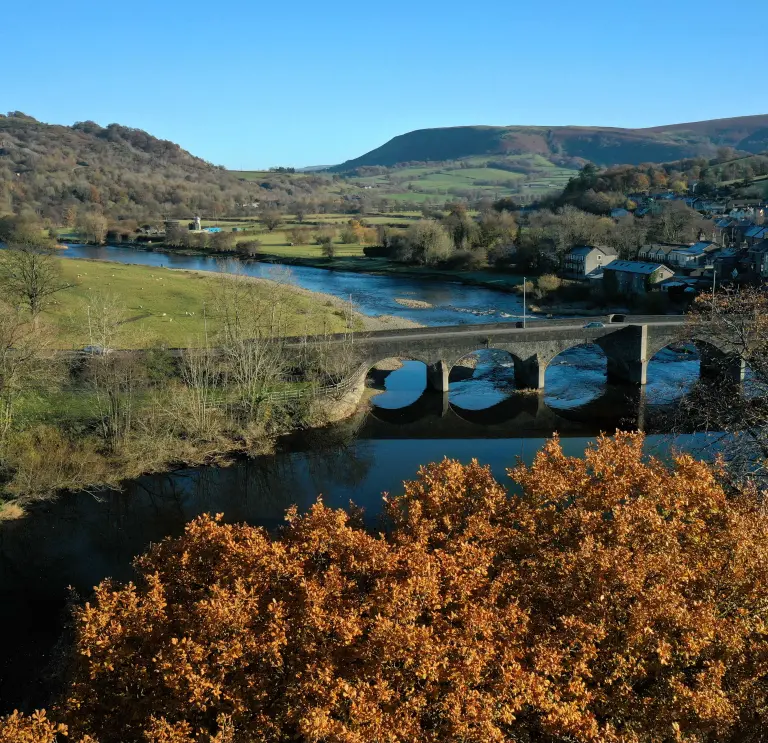Set off on your journey with the last Welsh born Prince of Wales
Arrive in Builth Wells from the West and the most colourful part of its history meets you straightaway, right by the river. The huge shop-side mural at the beginning of Broad Street depicts the last days of the last Welsh born Prince of Wales, Llywelyn the Last (Llywelyn Ein Llyw Olaf). In 1282, he fought for the very last time in this town, the Marcher Lords from England having snuck over the river downstream, and laid a trap for the Welsh.
This was the Battle of Irfon Bridge: follow Broad Street for two-thirds of a mile to get to the site of the bridge itself, but stop on the way for some sustenance. Welsh breakfasts get you battle-ready at the 14th century Fountain Inn, whose old locals might have remembered Llewelyn’s medieval woes.
If you want more Llewelyn lore and have brought your best walking boots, keep going out of town and walk two miles to Cilmeri, the site of where Llewelyn finally fell. A tall granite monolith elegantly marks the place where he died, while steps nearby lead you to the well where his severed head was said to be washed before it was sent on to Edward I. That grisly thought can be cleansed from your mind by a pint from Cilmeri’s Prince Llewelyn Inn (check opening hours before popping along).


Explore the mysterious sites of Builth Castle and the ancient church ruins
It’s not obvious that there was once a grand castle in the kingdom of Builth – and given there aren’t any obvious ruins to spot, explorers might struggle to find it. But sneak behind the row of houses on the helpfully-named Castle Road, and you’ll find the rolling, grassy motte of Builth Castle which once hosted one of Edward I’s most important fortresses.

Builth was an important place long before that. In post-Roman times, it was an independent kingdom. In the 9th and 10th centuries, it was the centre of Rhwng Gwy a Hafren (Between The Wye and the Severn), an important political region of Mid Wales, separated from the Kingdom of Powys, against whom Builth's defenders would frequently fight.
An earthwork by Doleglwys House (on the town’s Golfs Link Road) also conceals the ruins of an ancient church. Take all this in with a walk by the river. Then return to a local cafe for some old-fashioned restorative cawl or bara brith.
Enter Builth’s Victorian age
Builth is full of buildings made from stone from the nearby Llanelwedd Quarry: beautiful houses and shopfronts pepper every street. On Smithfield Street, there’s also a former Baptist chapel built in the very grand, late Victorian/gothic tradition, now home to a memorably-named antiques emporium, I Am Curious Yellow. Ring the doorbell, and you’ll enter a jaw-droppingly busy shop, crammed to the big seat and balcony with cheaply-priced furniture and chintzy interiors. (More modern antiques fans should also check out the brilliant Eco Chic Interiors on Strand Street, where vintage clothes, jewellery and customised Doc Martens decorate its wild-looking mannequins. Old paintings and animal heads sit on walls calmly, surveying the eccentricities
An even more impressive Victorian institution sits on the far side of Castle Street: the Wyeside Arts Centre. Builth Wells was once a popular Victorian spa town (the clue’s in the name), this was the town’s red-bricked cattle market, with rooms used for concerts, dances and public meetings. It’s now a busy independent theatre, showing new releases on its cinema screen, and it’s a busy stopping-off point for comedians, dance and theatre companies and musicians on national tours. The audience experience is memorable too: the seats tiering down sharply to the striking Victorian stage, which provides its own drama and atmosphere. Book your trip ahead to catch something here.


Builth’s brush with an American cowboy – and its other modern triumphs
It’s hard to be in Builth without a walk along the beautiful Wye, which is still wide here, and not long before it gets to its source at Plynlimon. Alongside the river, sits the bucolic Groe Park, where four not-particularly Welsh trees stretch up their trunks towards the skies, two by the Strand, and two by the town’s car park. These are giant redwoods, planted in 1903 just before American showman Buffalo Bill made his visit to his town; his shows, full of stories of the old American West, would attract huge crowds across Wales.

You’ll also find other parts of Builth’s history rubbing up close together: a striking stone circle, a grand war memorial and a statue of a prize bull for Builth’s local rugby team, The Bulls.


From Groe Park, you’ll also get the best views of Wye Bridge, built in 1779 – but altered sensitively to accommodate more than one cart in the 1920s. This adaptation proved particularly forward-thinking, given what happens just over the bridge every summer.
The Royal Welsh Show turns the town into the centre of the country in every possible way in July. Prize cattle, horses and sheep battle before thousands to win fabulous rosettes, and local food, sports and entertainment entertain the thousands.
And that's enough time travelling for now. Rest your ancient-feeling feet at The Strand by the river, and survey the land you've conquered, your head full of the past and the present – and hopefully still firmly on.









